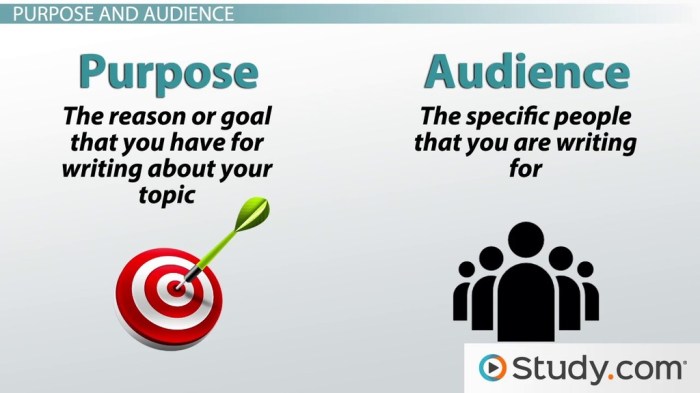Writing for Online Audience sets the stage for understanding the digital realm, where words hold the power to captivate and connect with readers. Dive into the art of online writing with a fresh perspective that resonates with today’s online audience.
Explore the nuances of crafting compelling content that not only informs but also entertains, while keeping the audience at the forefront of every word.
Understanding the Online Audience
Knowing the target online audience is crucial for effective communication. By understanding who will be reading your content, you can tailor your writing style to better connect with them and convey your message successfully.
Demographics and Writing Style
Demographics such as age, gender, location, education level, and income can greatly influence how you should write for online readers. For example, younger audiences may prefer more informal language and slang, while older audiences might appreciate a more formal tone. It’s important to consider these factors when crafting your content.
Psychographics and Tailoring Content
Psychographics delve deeper into the interests, values, attitudes, and behaviors of your target audience. By understanding these psychographic factors, you can create content that resonates with specific online audiences. For instance, if your audience values sustainability, you can incorporate environmentally-friendly practices into your content to appeal to them on a deeper level.
Writing Style for Online Readers

When it comes to writing for online audiences, it’s essential to keep in mind the characteristics that make content effective in capturing and maintaining reader interest. Online readers tend to have shorter attention spans, so it’s crucial to make your writing engaging, concise, and easy to digest. Utilizing a conversational tone, incorporating multimedia elements, and structuring your content for skimmability are all key components of successful online writing.
Engaging Writing Styles for Different Online Platforms
- On social media platforms like Instagram and Twitter, short and catchy captions paired with visually appealing images or videos can grab the attention of users scrolling through their feeds.
- For blog posts or articles on websites, using subheadings, bullet points, and numbered lists can help break up the text and make it more reader-friendly.
- In email newsletters, personalized storytelling and interactive elements like polls or surveys can increase reader engagement and encourage clicks.
- On video platforms such as YouTube, a combination of informative content, humor, and engaging visuals can keep viewers watching until the end.
Tips on Maintaining Reader Interest in Online Content
- Start with a strong and attention-grabbing headline to draw readers in from the start.
- Keep paragraphs short and to the point, using clear and concise language to convey your message effectively.
- Incorporate multimedia elements such as images, videos, infographics, and GIFs to enhance the visual appeal of your content.
- Encourage reader interaction through comments, polls, or social media sharing buttons to create a sense of community around your content.
- End with a call to action to prompt readers to take the next step, whether it’s visiting your website, signing up for a newsletter, or sharing the content with their network.
Tailoring Content for Online Consumption: Writing For Online Audience
When it comes to creating content for an online audience, it’s essential to tailor your writing to suit their preferences. Online readers have shorter attention spans and are often looking for information that is concise, engaging, and easy to digest. Here are some strategies to help you adapt your content for online consumption.
Adapting Content for Online Readers
- Break up your content into shorter paragraphs: Online readers prefer content that is easy to scan and digest quickly. Break up your text into shorter paragraphs to make it more reader-friendly.
- Use subheadings to organize your content: Subheadings help readers navigate your content and find the information they are looking for more easily.
- Incorporate bullet points and numbered lists: Lists help break up the text and make key points stand out, making it easier for readers to grasp the main ideas.
Importance of Visuals in Online Content
Visual elements such as images, infographics, and videos play a crucial role in enhancing online content. They help break up the text, make the content more engaging, and appeal to different types of learners. Visuals can also help convey complex information more effectively and leave a lasting impression on the audience.
Optimizing Content for Search Engines
- Use relevant s: Incorporate relevant s naturally throughout your content to help search engines understand what your content is about.
- Optimize meta tags and descriptions: Write compelling meta tags and descriptions that accurately represent your content and encourage users to click through to your website.
- Create high-quality, shareable content: Search engines prioritize content that is valuable and shareable. Focus on creating content that is informative, engaging, and provides value to your audience.
Creating Engaging Headlines and Introductions

When it comes to online articles, crafting attention-grabbing headlines is key to attracting readers. Your headline should be concise, clear, and intriguing to entice people to click and read your content. Here are some tips for creating engaging headlines for online articles:
Tips for Crafting Attention-Grabbing Headlines:
- Use numbers or lists to make your headline stand out.
- Pose a question that piques curiosity.
- Include power words that evoke emotion or urgency.
- Keep it short and to the point.
A compelling introduction is just as important as a catchy headline. Your introduction sets the tone for the rest of your content and should captivate readers from the start. Here are some techniques for structuring headlines and introductions to maximize reader engagement:
Techniques for Structuring Headlines and Introductions:, Writing for Online Audience
- Start with a shocking statistic or intriguing fact to grab attention.
- Tell a story that relates to your topic to draw readers in.
- Pose a thought-provoking question that encourages readers to keep reading for the answer.
- Use bold statements or quotes that highlight the main point of your article.